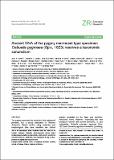Por favor, use este identificador para citar o enlazar a este item:
http://hdl.handle.net/10261/263390COMPARTIR / EXPORTAR:
 SHARE SHARE
 CORE
BASE CORE
BASE
|
|
| Visualizar otros formatos: MARC | Dublin Core | RDF | ORE | MODS | METS | DIDL | DATACITE | |

| Título: | Ancient DNA of the pygmy marmoset type specimen Cebuella pygmaea (Spix, 1823) resolves a taxonomic conundrum |
Autor: | Boubli, Jean P.; Janiak, Mareike C.; Porter, Leila M.; Torre, Stella de la; Cortés-Ortiz, Liliana; Silva, Felipe E.; Rohe, Fabio; Vries, Dorien de; Beck, Robin M. D.; Ruiz-Gartzia, Irune; Kuderna, Lukas F. K. CSIC ORCID; Marqués-Bonet, Tomàs CSIC ORCID ; Hrbek, Tomas; Farias, Izeni P.; Heteren, Anneke H. van; Roos, Christian | Palabras clave: | Historic DNA Pygmy marmoset C. niveiventris Amazon Type specimen DNA taxonomy Cabuella pygmaea |
Fecha de publicación: | 18-nov-2021 | Editor: | Science Press | Citación: | Zoological Research 42: 761- 771 (2021) | Resumen: | The pygmy marmoset, the smallest of the anthropoid primates, has a broad distribution in Western Amazonia. Recent studies using molecular and morphological data have identified two distinct species separated by the Napo and Solimões-Amazonas rivers. However, reconciling this new biological evidence with current taxonomy, i.e., two subspecies, Cebuella pygmaea pygmaea (Spix, 1823) and Cebuella pygmaea niveiventris (Lönnberg, 1940), was problematic given the uncertainty as to whether Spix's pygmy marmoset (Cebuella pygmaea pygmaea) was collected north or south of the Napo and Solimões-Amazonas rivers, making it unclear to which of the two newly revealed species the name pygmaea would apply. Here, we present the first molecular data from Spix's type specimen of Cebuella pygmaea, as well as novel mitochondrial genomes from modern pygmy marmosets sampled near the type locality (Tabatinga) on both sides of the river. With these data, we can confirm the correct names of the two species identified, i.e., C. pygmaea for animals north of the Napo and Solimões-Amazonas rivers and C. niveiventris for animals south of these two rivers. Phylogenetic analyses of the novel genetic data placed into the context of cytochrome b gene sequences from across the range of pygmy marmosets further led us to reevaluate the geographical distribution for the two Cebuella species. We dated the split of these two species to 2.54 million years ago. We discuss additional, more recent, subdivisions within each lineage, as well as potential contact zones between the two species in the headwaters of these rivers. | Versión del editor: | http://dx.doi.org/10.24272/j.issn.2095-8137.2021.143 | URI: | http://hdl.handle.net/10261/263390 | DOI: | 10.24272/j.issn.2095-8137.2021.143 | Identificadores: | doi: 10.24272/j.issn.2095-8137.2021.143 issn: 2095-8137 |
| Aparece en las colecciones: | (IBE) Artículos |
Ficheros en este ítem:
| Fichero | Descripción | Tamaño | Formato | |
|---|---|---|---|---|
| Ancient_DNA_Cebuella_pygmaea.pdf | 7,29 MB | Adobe PDF |  Visualizar/Abrir |
CORE Recommender
Page view(s)
53
checked on 23-abr-2024
Download(s)
42
checked on 23-abr-2024
Google ScholarTM
Check
Altmetric
Altmetric
Este item está licenciado bajo una Licencia Creative Commons

